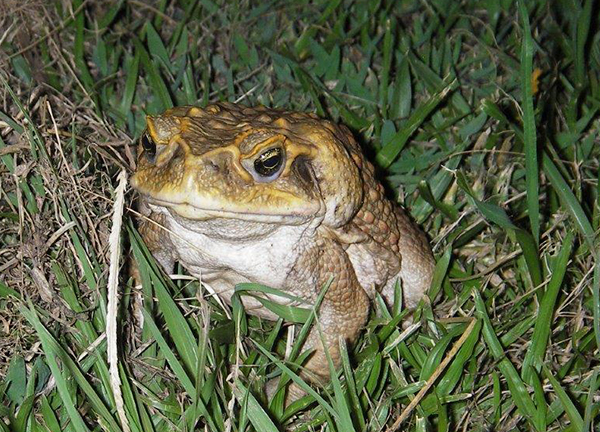Introduction
Cane toads are a major pest in the Northern Territory (NT).
They are spreading throughout northern Australia and are a threat to native wildlife.
Cane toads are toxic if the toxin is ingested or rubbed into your eyes.
The source of the toxin is two large glands behind the eyes and on the back of the neck. The toxin is usually on the toad's skin, but can be sprayed lightly if the toad is handled roughly.
This guide has information on how to identify a cane toad, reporting a cane toad and how to get rid of cane toads.
How to identify a cane toad
Eggs
Cane toad eggs are laid in long chains with individual eggs which look like black beads encased in jelly. Often eggs are placed in double rows along the strand.
Several females will generally lay eggs in the same water and each female lays up to 35,000 eggs.
Strands of eggs often become tangled and look like a mass of eggs.
If you pick up the eggs with a rake or a stick, the individual strands will hang down.
Tadpoles
Cane toad tadpoles are shiny black on top and have a plain dark bluish grey or black belly.
The body is an oval shape, pointed at the snout and often broad across the gills.
The fins are totally transparent.
The tail is short, thin and rounded at the tip. It is usually 1.25 to 1.5 times the length of the body.
Tadpoles are small and only grow to 30mm in length, with the body about 11mm long at most.
Toad tadpoles tend to form large, slow-moving groups.
They do not come up to the surface to breathe like the tadpoles of native frogs.
Juveniles
Juvenile cane toads are quite different to adults, with smoother, darker skin, darker blotches and bars and a lack of obvious parotoid glands on their backs.
Any toads under 4cm may look similar to a native frog.
You can tell them apart by their upright stance.
They also cluster near water and are active during the day.
Adults
Adult cane toads are large, generally 9cm to 15cm long, but can grow up to 24cm.
They are heavily built and the skin on top is rough, dry and covered in warts. The colour can vary from grey, olive, yellow-brown to red-brown.
Their underparts are lighter and usually a mottled brown.
Their heads are bony with a pointed snout and there is a distinctive ridge over their eyes that meets above their nose.
Behind and just below each eye is a distinctive circular ear drum.
On top of each shoulder is a large sack - this is the toxin-producing parotoid gland.
Cane toads have slightly webbed, leathery hind feet, while the front feet have no webbing and are relatively small in size.
They have an upright stance and walk or move small distances in short, rapid hops, unlike most native species, which leap.
Male toads have a distinctive call, a high-pitched broken brrrr sound that has sounds similar to a motor running, a telephone dial tone or a long loud purring trill.
Cane toads prefer places that are well lit and often group in open areas to find food.
They are unable to jump high and are poor climbers. They also need daily access to water.
More information
For more on cane toad identification, get the poster PDF (317.3 KB).
How to collect and dispose of cane toads
Cane toads are toxic.
You need to first identify the cane toad.
Follow these steps to safely collect a toad:
Step 1. Wear eye protection.
Step 2. Wear gloves or use doubled-up plastic bags to protect your hands.
Step 3. If using plastic bags, put one bag inside the other and turn the bags inside out, grab the toad and turn the bags back out the right way and tie the top.
Step 4. Wash your hands thoroughly with soap afterwards.
To dispose of a toad humanely, put your bagged toad in the refrigerator at four degrees for an hour so that it becomes unconscious.
Then transfer the toad to the freezer for at least 16 hours.
You can bury the toad or put it in the compost as it is a safe natural fertiliser. Make sure the toad is away from pets.
You can also take live cane toads to a toad detention centre at one of the following locations:
- The Shoal Bay Recycling Centre Darwin
- Archer Dump Palmerston
- Berry Springs Primary School
- Fred's Pass.
How to control cane toads
You can help control the cane toad problem in the Northern Territory (NT) by doing all of the following:
- use yellow fluorescent tubes for lighting around your home instead of white fluorescent tubes, as cane toads are attracted to the white light
- regularly check any water containers in your garden for cane toad eggs or tadpoles - this includes pools, ponds and water features - and empty any containers that you are not using, such as pot plant saucers
- remove any cane toad eggs you find by lifting them gently out of the water and placing the eggs in your compost bin, bury them, put them in the sun to dry out or place them in a sealable plastic bag to dispose in the bin - wear disposable gloves when handling eggs
- check your load when travelling into parts of Australia not inhabited by cane toads - they will often hide in camping gear, pot plants or boxes of fruit
- collect and dispose of cane toads safely, but make sure to identify it as a cane toad first.

